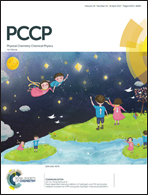in/out Isomerism of cyclophanes: a theoretical account of 2,6,15-trithia-[34,10][7]metacyclophane and [34,10][7]metacyclophane as well as their halogen substituted analogues†
Abstract
A detailed theoretical investigation of cyclophanes with a divergent set of methods ranging from molecular mechanics through semiempirical to ab initio is presented. Cyclophanes have attracted interest over the years due to their unusual chemistry and increasing applications. There has been previous debate over the effects contributing to the greater stability of more-crowded in isomers of certain cyclophanes, and a higher strain in the out isomer was the prevailing explanation. Application of EDA–NOCV and SAPT analysis has enabled us to distinguish between different effects controlling isomer stability and determine the significance of all effects involved. Our results show that, although strain has a large significance, orbital stabilization within the molecule from the aromatic electron density is crucial. Furthermore, we analysed halogen-substituted cyclophanes in order to further understand these subtle effects.
![Graphical abstract: in/out Isomerism of cyclophanes: a theoretical account of 2,6,15-trithia-[34,10][7]metacyclophane and [34,10][7]metacyclophane as well as their halogen substituted analogues](/en/Image/Get?imageInfo.ImageType=GA&imageInfo.ImageIdentifier.ManuscriptID=C7CP00557A&imageInfo.ImageIdentifier.Year=2017)


 Please wait while we load your content...
Please wait while we load your content...